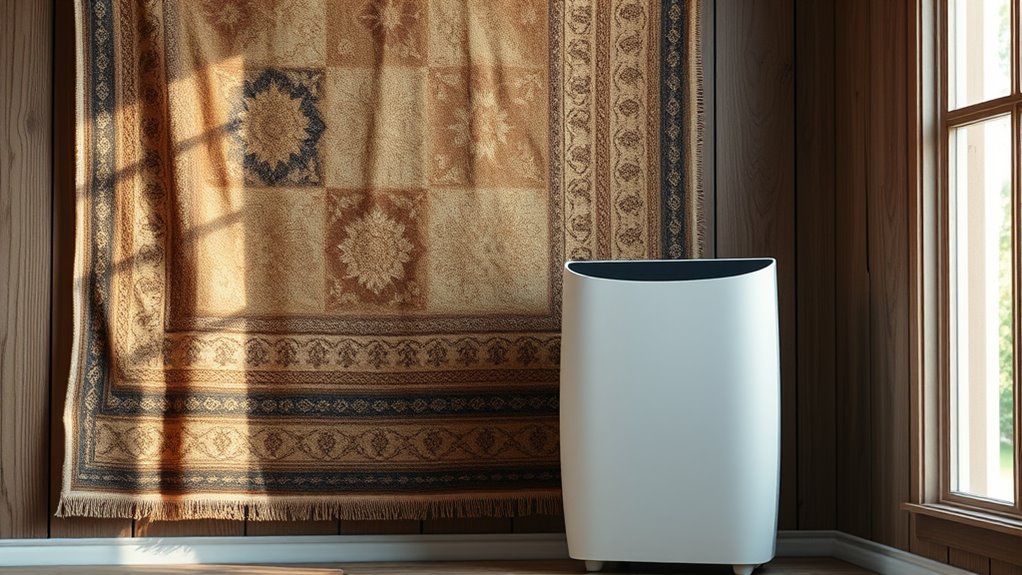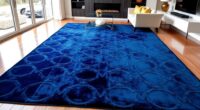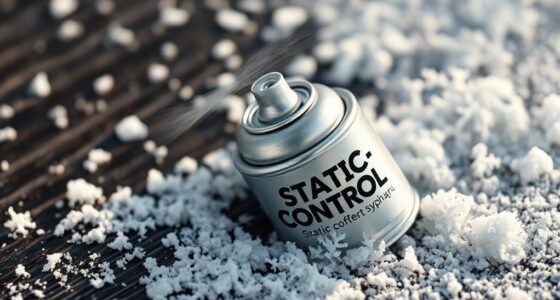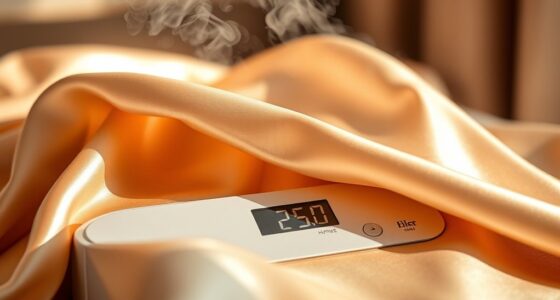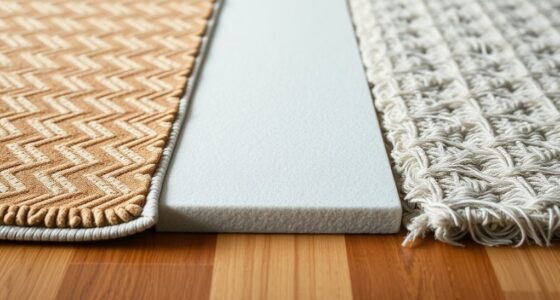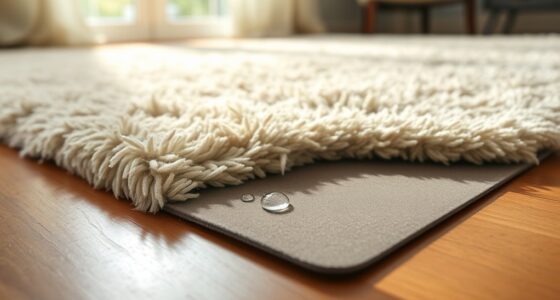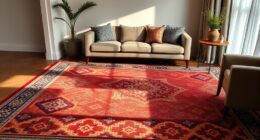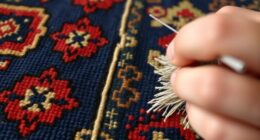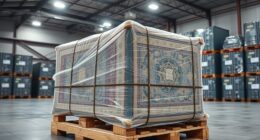If you want to protect your antique textiles from airborne pollutants, dust, and odors that can cause irreversible damage, investing in an air purifier is a smart choice. Look for models with HEPA and activated carbon filters, and avoid ozone-emitting devices. Properly chosen, a good air purifier can help maintain a stable environment and prolong your textiles’ life. To understand which options suit your collection best, keep exploring the details below.
Key Takeaways
- Air purifiers remove airborne pollutants, dust, and allergens that can accelerate textile deterioration and fading.
- HEPA and activated carbon filters effectively protect antique fabrics from dust, odors, and chemical emissions.
- Properly selected air purifiers help maintain stable humidity and prevent pest attraction, preserving textiles long-term.
- Avoid devices emitting ozone or harsh chemicals that could damage delicate fabrics or cause chemical reactions.
- Using a suitable air purifier is a proactive, cost-effective way to enhance indoor air quality and safeguard antique textiles.
Understanding the Risks to Antique Textiles
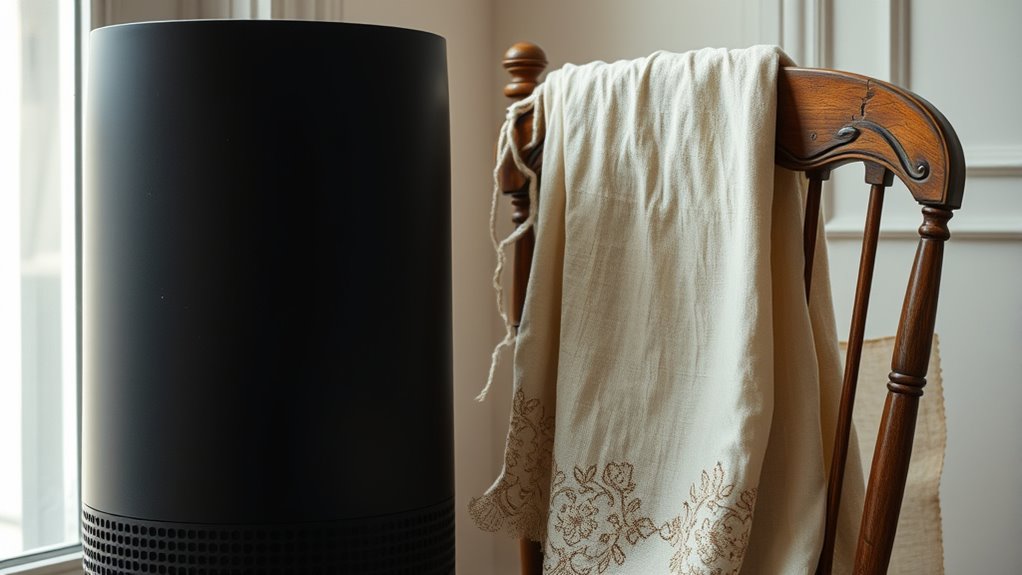
Have you ever wondered how indoor air quality can threaten your antique textiles? Environmental factors like humidity, pollution, and dust can accelerate deterioration, causing fading and weakening fibers. Chemical treatments used in preservation or cleaning may seem helpful but can sometimes harm delicate fabrics if not applied carefully. These chemicals can emit volatile organic compounds (VOCs), which contribute to the buildup of airborne pollutants that settle into textiles. Over time, exposure to such pollutants and chemicals can lead to irreversible damage, such as discoloration and fiber breakdown. Additionally, air purifier technology can help reduce airborne particles and VOCs, offering an effective way to protect your treasured textiles from long-term deterioration. Understanding these risks helps you recognize the importance of controlling indoor air quality. By minimizing harmful environmental influences and chemical treatments, you can better protect your treasured textiles from long-term deterioration.
How Air Purifiers Filter Pollutants and Allergens

Ever wondered how air purifiers actually remove pollutants and allergens from your indoor environment? They use various filters to improve air quality by trapping harmful particles. HEPA filters are especially effective at capturing pollen, dust mites, pet dander, and smoke particles. Activated carbon filters absorb odors, gases, and volatile organic compounds (VOCs), further enhancing pollutant removal. The air purifier pulls in contaminated air, filters out pollutants, and releases cleaner air back into your space. This process helps reduce allergy symptoms and protects your textiles from airborne contaminants. Additionally, filter technology continues to evolve, offering even more efficient ways to purify indoor air. Below is a quick overview of common filter types:
| Filter Type | Main Function |
|---|---|
| HEPA | Captures small particles like dust and pollen |
| Activated Carbon | Absorbs gases and odors |
| Pre-filters | Trap larger particles, prolong filter life |
| UV-C Light | Kills bacteria and viruses |
| Ionizers | Charge particles for easier removal |
Types of Air Purifiers Suitable for Vintage Fabrics
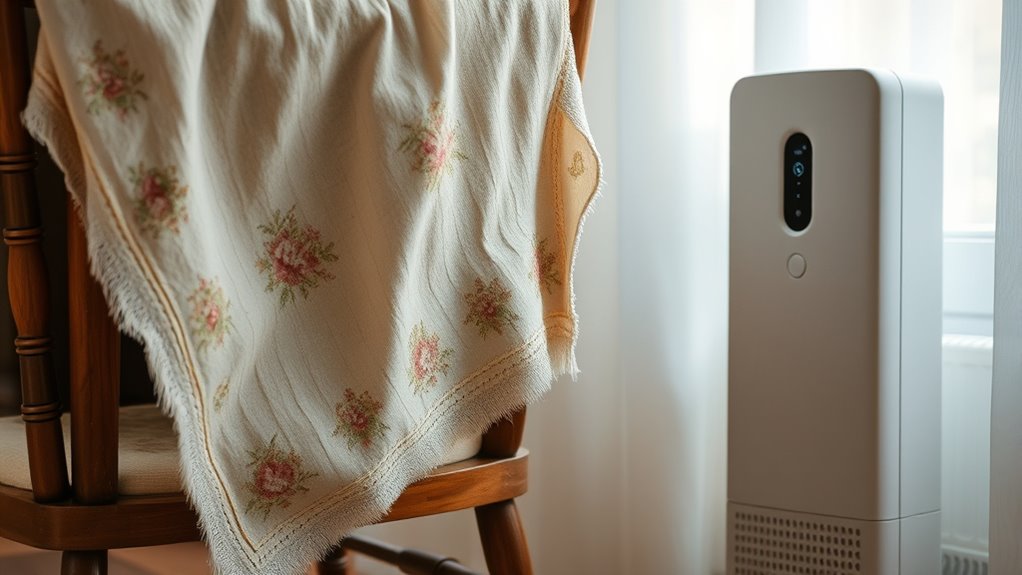
To protect vintage fabrics from airborne pollutants and environmental damage, choosing the right air purifier is essential. The best air purifier types for vintage textile protection focus on removing dust, pollutants, and odors without emitting ozone or harsh chemicals. Look for units with HEPA filters, which trap small particles and allergens effectively. Activated carbon filters are also beneficial for odor control and chemical pollutants that can damage delicate fabrics. UV-C purifiers can kill bacteria and mold spores, reducing biological threats. Consider these options to ensure your antique textiles stay pristine:
- HEPA filter air purifiers for dust and allergen removal
- Activated carbon filters for odor and chemical absorption
- UV-C sterilizers for biological threat control
Selecting the right type supports vintage textile protection and preserves their beauty over time. Proper planning can help you choose the most suitable air purifier based on your specific needs and environmental conditions.
Evaluating the Impact of Air Purifiers on Antique Preservation
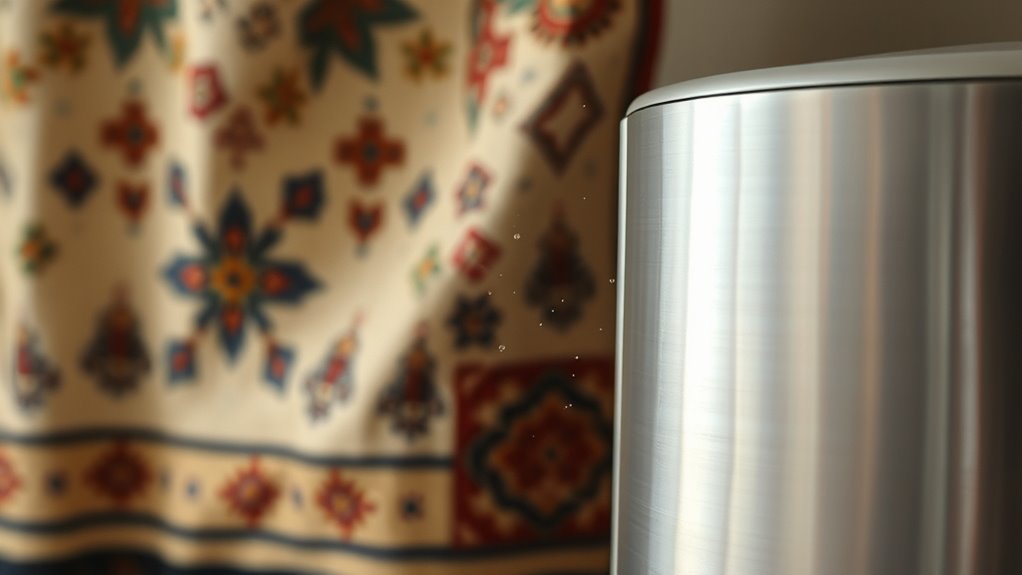
Evaluating how air purifiers affect antique preservation involves understanding both their benefits and potential risks. Proper humidity control is essential, as air purifiers with humidifiers can help maintain stable moisture levels, preventing fabric deterioration caused by dryness or excess dampness. Additionally, air purifiers can aid in pest prevention by removing airborne particles that attract insects, reducing the risk of infestation. However, some purifiers may produce ozone or other byproducts that could harm delicate textiles over time. It’s important to choose devices specifically designed for antique preservation, ensuring they support stable humidity and do not emit harmful substances. Furthermore, understanding AI Safety measures can help prevent unintended damage from malfunctioning devices. Ultimately, when used correctly, air purifiers can enhance preservation efforts by reducing airborne pollutants and controlling environmental factors that threaten your vintage fabrics.
Factors to Consider Before Investing in an Air Purifier
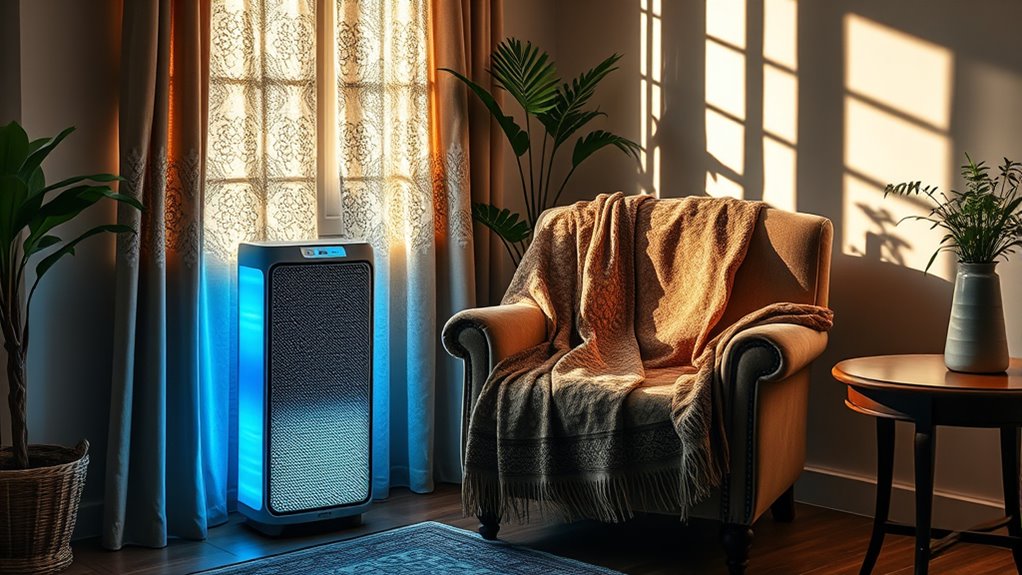
Before buying an air purifier, you need to contemplate if it fits your room size and effectively filters pollutants without costing too much. Think about how loud it will be and what kind of maintenance it requires to keep it running smoothly. Addressing these factors helps you choose a model that protects your antique textiles while fitting your needs. Additionally, considering the filter type ensures that you select a device capable of capturing small particles and allergens effectively.
Room Size Compatibility
Choosing the right air purifier starts with understanding the size of the room you want to clean. An undersized unit won’t effectively filter pollutants, while an oversized one may be unnecessary and waste energy. Consider these factors:
- The room’s square footage to guarantee proper coverage
- Your need for humidity control to prevent mold or excessive dryness
- Pest prevention, especially in areas prone to insects or rodents
- The presence of airborne allergens like pollen or pet dander which can be mitigated with appropriate filtration HEPA filtration
Matching your air purifier to your space ensures ideal air quality for antique textiles, reducing dust and airborne allergens. Proper sizing helps maintain a comfortable environment and protects delicate fabrics from damage caused by excess humidity or pests. Remember, a well-sized purifier boosts efficiency and conserves energy, making it a smart investment for preserving your textiles and improving overall air quality.
Filter Effectiveness & Cost
Understanding the effectiveness and cost of filters is essential before investing in an air purifier, especially when protecting delicate antique textiles. Air purifier filtration varies widely, with HEPA filters capturing tiny particles like dust and mold spores, which are critical for preserving textiles. Consider the filter’s efficiency and the types of pollutants it targets. A higher-quality filter often means better protection but can come with a higher initial price and more frequent replacements. Conduct a cost analysis to evaluate ongoing expenses, including filter replacements and maintenance. Cheaper filters may seem appealing but could compromise filtration effectiveness, risking your textiles’ safety. Balancing filter performance with affordability ensures you choose an air purifier that offers ideal protection without undue costs over time. Additionally, fabric decorating markers can be used to personalize the surroundings or labels for textiles, emphasizing the importance of maintaining both aesthetic and preservation standards.
Noise and Maintenance
While evaluating filter effectiveness and cost is key to selecting an air purifier, it’s also important to contemplate noise levels and maintenance costs. Noisy units can disrupt your daily activities or sleep, so check decibel ratings before buying. Additionally, high maintenance costs can add up over time, especially if filters need frequent replacement or cleaning. To help you decide, weigh these points:
- Choose a model with adjustable fan speeds to control noise.
- Look for filters that are easy to replace or clean.
- Factor in the frequency of filter replacements to estimate ongoing costs.
- Understanding industry transformations can guide you toward more innovative and future-proof options.
Balancing these factors ensures you get an air purifier that’s both effective and unobtrusive, saving you money and hassle in the long run.
Best Practices for Displaying and Storing Antique Textiles
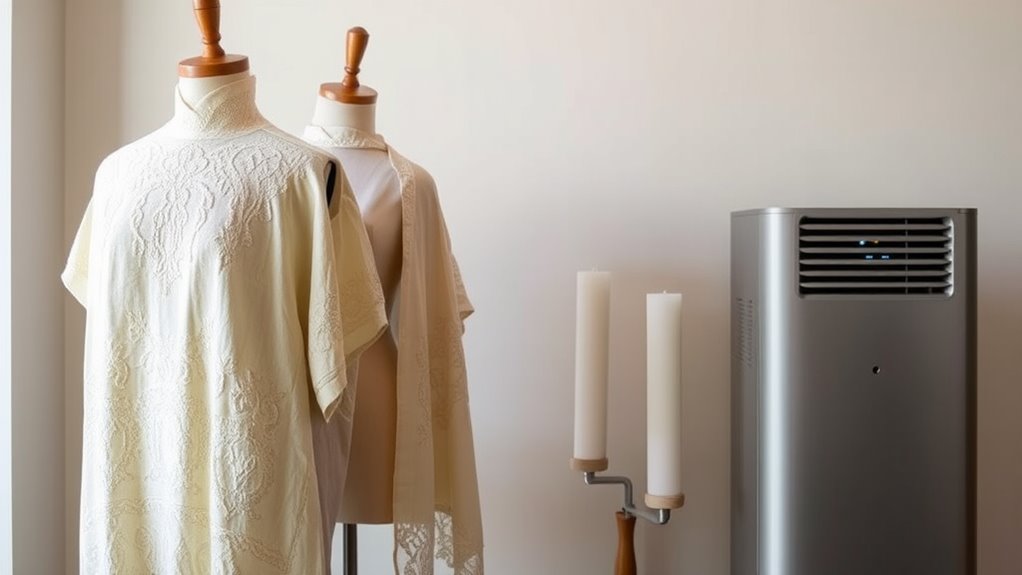
To safeguard your antique textiles, you need to create a preservation environment that limits exposure to light, humidity, and pests. Proper display techniques, like using acid-free mounts and avoiding direct sunlight, help prevent deterioration. Storing textiles correctly ensures they stay intact and vibrant for years to come. Additionally, understanding bike maintenance can be beneficial if you plan to transport or display your textiles at outdoor events or exhibitions.
Preservation Environment Control
Proper environment control is essential for preserving antique textiles, whether they are on display or in storage. Maintaining stable conditions helps prevent damage and prolongs their lifespan. Focus on:
- Humidity control to keep moisture levels steady, avoiding mold or desiccation.
- Pest prevention by sealing storage areas and inspecting textiles regularly.
- Temperature regulation to prevent fluctuations that can weaken fibers.
Proper Display Techniques
Effective display techniques are essential for showcasing antique textiles while ensuring their preservation. Proper display lighting is vital; avoid direct sunlight and intense lighting, which can cause fading and deterioration. Instead, opt for low-intensity, UV-filtered lights that highlight the textile’s details without damage. Temperature regulation is equally important—keep the environment stable, ideally between 65-70°F, to prevent fabric brittleness or mold growth. Never pin or tape textiles directly to surfaces; instead, use acid-free mounts or support fabrics that distribute weight evenly. When storing textiles, avoid folding for long periods; instead, roll or store flat in acid-free boxes. Consistent climate control and thoughtful lighting help preserve your antique textiles for future generations. Additionally, understanding vetted products designed for textile preservation can provide added protection during display and storage.
Alternative Methods to Protect Your Vintage Fabrics

When safeguarding your vintage fabrics, exploring alternative methods beyond air purifiers can make a significant difference. You can enhance preservation by considering historical fabric treatments that have stood the test of time, such as gentle washing and careful storage. Protecting textile dye stability is also essential; avoid direct sunlight and high humidity that can cause colors to fade or bleed.
To bolster your efforts, consider these methods:
- Using acid-free storage materials to prevent deterioration
- Regularly inspecting fabrics for signs of pests or mold
- Implementing controlled environments with stable temperature and humidity
These approaches help maintain your textiles’ integrity, ensuring they remain vibrant and intact for generations to come.
Cost and Maintenance of Air Purification Systems
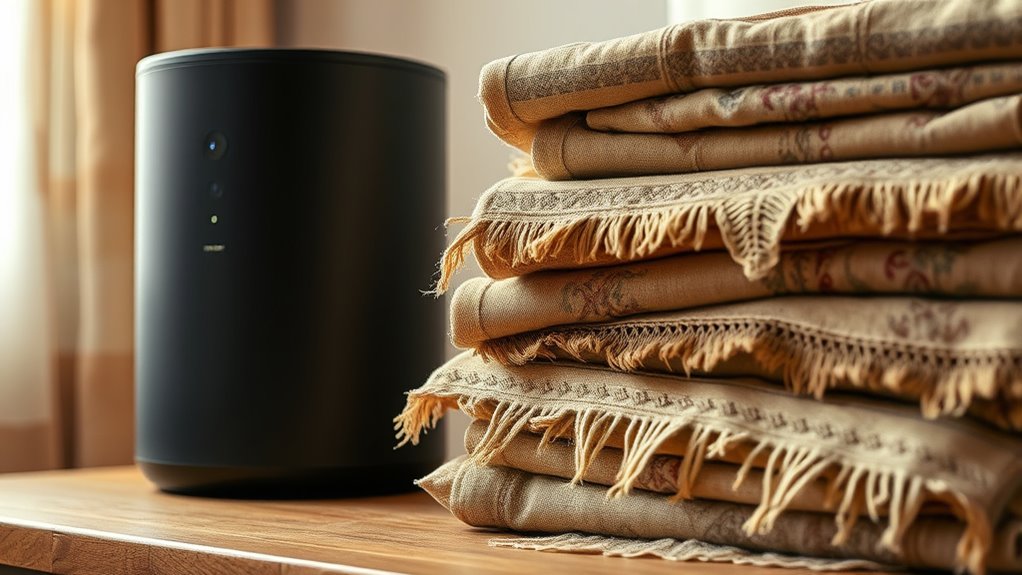
While exploring alternative methods to protect vintage fabrics is helpful, many collectors turn to air purification systems for added defense against dust, pollutants, and pests. The cost analysis of these systems varies depending on size, features, and brand, with prices ranging from affordable models to high-end units. Keep in mind, initial investment isn’t the only expense; maintenance routines also impact your budget. Regularly replacing filters, typically every 6 to 12 months, is essential to ensure peak performance. Some systems require more frequent filter changes or occasional component checks. While maintenance costs add up over time, a well-maintained purifier can extend the life of your textiles. Before buying, assess both the upfront costs and ongoing expenses to determine what fits your budget and preservation needs.
Expert Opinions on Air Purifiers and Antique Textile Care
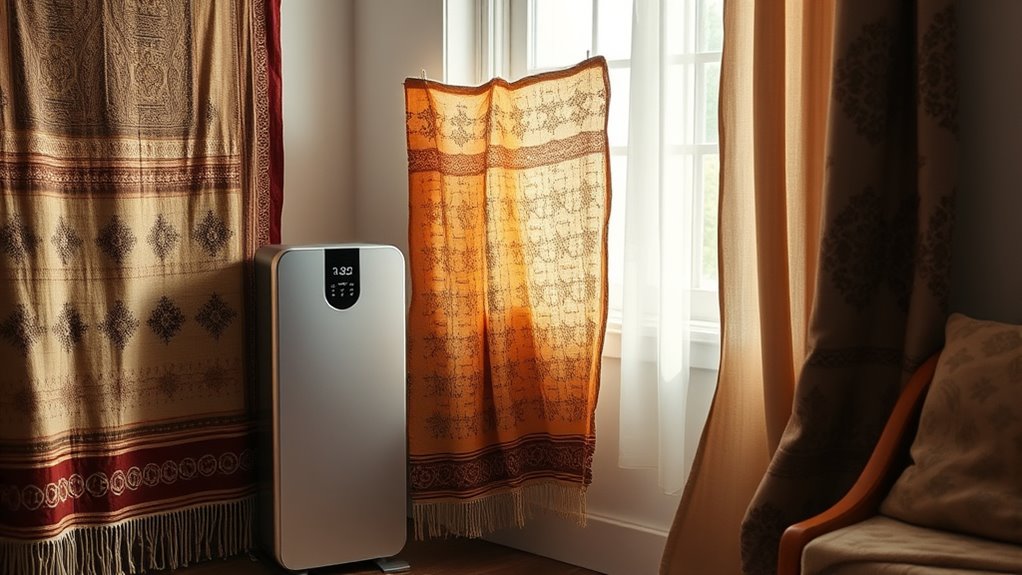
Experts agree that air purifiers can help protect antique textiles from pollutants and dust. Many recommend specific models designed to preserve delicate fabrics without causing damage. You should consider their advice to guarantee your treasured textiles stay preserved for years to come.
Air Purifiers for Textiles
Air purifiers play a crucial role in preserving antique textiles by reducing airborne pollutants that can cause deterioration. They improve air quality, helping to prevent dust, mold spores, and airborne chemicals from settling on delicate fabrics. For textile preservation, choosing the right purifier is essential. Look for features like HEPA filters to trap tiny particles, activated carbon filters for odors and chemicals, and adequate airflow for continuous cleaning. These devices can substantially extend the lifespan of your textiles by maintaining a cleaner environment. Keep in mind that an effective air purifier:
- Reduces dust accumulation on fabrics
- Limits mold and bacteria growth
- Minimizes chemical exposure that can harm textiles
Investing in a quality air purifier supports your goal of protecting antique textiles for generations.
Preserving Antique Fabrics
Consulting with conservation professionals reveals that using high-quality air purifiers is essential for maintaining the integrity of antique fabrics. Air purifiers help reduce dust, pollutants, and airborne contaminants that can compromise fabric durability over time. By controlling these environmental factors, you protect the fibers from deterioration caused by pollutants and fluctuations in humidity. Additionally, air purifiers help preserve dye stability, preventing fading or discoloration that can occur from exposure to airborne chemicals. Maintaining a stable environment minimizes the risk of mold and pests, which can damage delicate textiles. To ensure your antique fabrics stay vibrant and intact, invest in reliable air purifiers and monitor your storage conditions. Proper care and a controlled environment are key to preserving the beauty and historical value of your textiles.
Making an Informed Decision for Your Collection
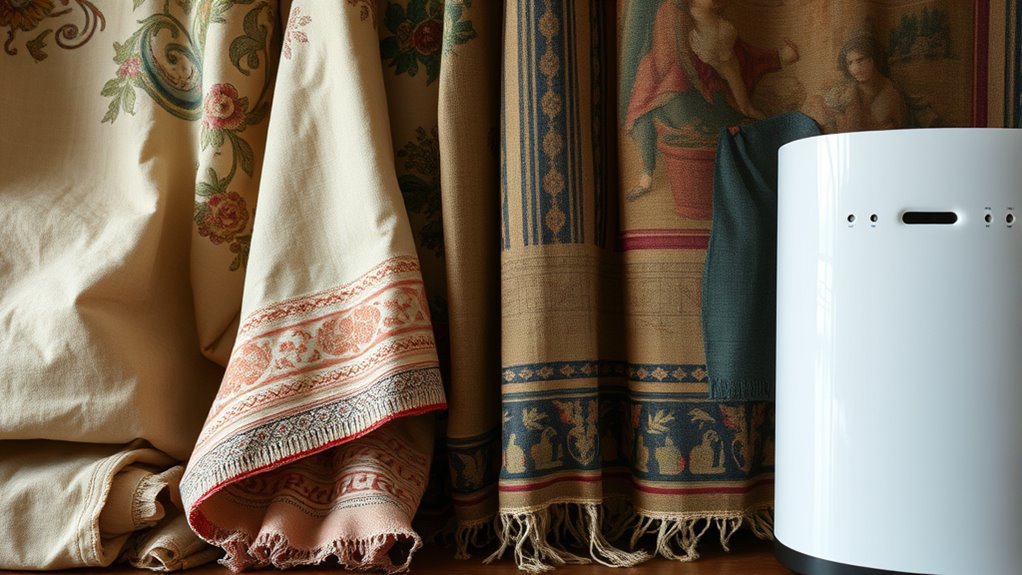
When considering whether to use air purifiers for your antique textiles, it’s essential to gather reliable information and weigh your options carefully. Properly maintaining your collection involves understanding the benefits of textile cleaning and antique restoration techniques. Air purifiers can reduce airborne pollutants, but they’re not a one-size-fits-all solution. To make an informed choice, consider:
- The type of textiles you own and their specific needs
- The environment where your collection is stored
- Potential risks of pollutants and pests
Research thoroughly, consult experts, and evaluate whether air purifiers complement your current preservation efforts. Remember, combining good airflow, humidity control, and proper cleaning methods can considerably extend the lifespan of your textiles. Making smart decisions now saves time and preserves your collection for the future.
Frequently Asked Questions
How Often Should I Replace Filters in My Air Purifier for Antique Textiles?
You should replace filters in your air purifier every 3 to 6 months, depending on usage and filter type. Regular filter maintenance is essential to keep your purifier working efficiently and extend its lifespan. If you notice reduced airflow or increased odors, it’s time for a replacement. Proper filter care guarantees your antique textiles stay protected from dust and pollutants, maintaining their condition over time.
Can Air Purifiers Eliminate All Types of Indoor Pollutants Harmful to Fabrics?
You might wonder if air purifiers can eliminate all pollutant types harmful to fabrics. While they effectively reduce many indoor pollutants like dust, pollen, and certain odors, their filter effectiveness varies depending on the pollutant. Some filters, like HEPA, trap particles well, but gases or VOCs may require specialized filters. So, air purifiers help, but they might not eliminate every harmful pollutant for your antiques.
Are There Specific Air Purifier Models Recommended for Vintage Textile Collections?
Sure, because everyone dreams of matching their vintage textiles with the latest tech. When choosing air purifier models for your precious textiles, look for those with HEPA filters and low ozone emission. Brands like Molekule and Blueair are often recommended. They help trap dust, pollen, and other pollutants, ensuring your vintage textiles stay pristine. After all, who wouldn’t want their antiques to breathe the same clean air as a modern art gallery?
How Do I Balance Air Quality Improvement With Preserving Delicate Textiles?
You want to improve air quality without risking damage, so focus on humidity control and minimizing chemical exposure. Keep humidity levels stable around 50% to prevent mold and deterioration. Use air purifiers with activated carbon filters to reduce chemical pollutants, but make certain they’re gentle enough for delicate textiles. Regularly ventilate your space and avoid harsh cleaning agents, protecting your textiles while maintaining a healthier environment.
What Are the Long-Term Effects of Air Purifiers on Antique Textile Preservation?
Think of air purifiers as guardians, much like the Keepers of the Ring in Lord of the Rings. Over time, they can help protect your textiles by controlling humidity and filtering chemicals that cause deterioration. However, prolonged use might lead to overly dry air, risking damage. Regular maintenance and choosing models with humidity control and chemical filtration help make certain your antique textiles stay preserved and vibrant for years.
Conclusion
Ultimately, protecting your antique textiles is like balancing a delicate dance—between shielding them from harmful pollutants and preserving their fragile beauty. While air purifiers act as silent guardians, they can’t replace careful handling and proper storage. Think of them as a gentle breeze in a dusty room, not a storm that clears everything away. By weighing your options wisely, you’ll create a safe haven where vintage fabrics can breathe, flourish, and tell their stories for generations.
